Establishment of a basis for administrative use of PestSurf
Annex 1
1 Comparison of risk assessment data produced by spray drift assessments, FOCUS SW and PestSurf
1.1 Chemical characteristics of the compound
| Compound: | Alpha-cypermethrin |
| Dose: | 15 g ai/ha |
| Spraying time: | 1st of June |
| Crop: | Winter wheat |
Table 1.1. Overview of chemical properties of alpha-cypermethrin and the parameters used in the simulations.
Tabel 1.1. Oversigt over alpha-cypermethrins kemiske egenskaber og parametrene brugt i simuleringerne.
| Chemical property | Condition | Recalculated values | |||
| Cas-no. | 67375-30-8 | ||||
| Molecular weight | 416.3 g/mol | ||||
| Form (acid, basic, neutral) | Neutral | ||||
| pKa | |||||
| Water solubility | 3.97 µg/l | pH 7 | |||
| log Kow | at pH | KowA- | |||
| log Kow | 5.5 | at pH | KowAH | 5.5 | |
| log Kow | at pH | KowAH+ | |||
| Vapor pressure, Pa | 3.4 × 10-7 (97.3%) | 25 °C | 270 °C (Decomposition) | vapor pressure, Pa, 20°C | 1.25 × 10-7 |
| Henry’s law constant | 0.069 Pa.m³ mol-1 | 20 °C | Recalculated value, dimensionless | 2.83 × 10-5 | |
| Sorption properties in soil | |||||
| Freundlich exp | 1 | ||||
| Koc, l/kg | 57889 | ||||
| DT50 in soil, days | 103 | ||||
| DT50water | 1.25 days | PestSurf input | |||
| DT50sedment | Water/sediment value used due to strong sorption |
||||
| DT50water/sediment | 20.9 days | method not described | DT50, days | 20.9 | |
| Sediment konc., µg/l | 80 (default in PestSurf) | ||||
| Hydrolysis | None | at pH 5 | (acid) | Indef | |
| 101 | at pH 7 | (neutral) | Indef | ||
| 7.3 | at pH 9 | (basic) | 5.5 × 10-6 | ||
| Photolysis | |||||
| quantum yield | φ = 8.12 × 10-3 | ||||
| Spectrum | at λmax (276 nm) : ε = 2073 l.mol-1.cm-1 | ||||
| at 300 nm : ε = 38.64 l.mol-1.cm-1 | |||||
| Other | at pH 5, 22 °C : DT50 = 1.2 d (Cp-label) – 2.2 d (Bz-label) | ||||
1.2 Concentration generated by spray
| Direct spray | FOCUS buffer zones | |||
| Ditch | Stream | Pond | ||
| [µg L-1] | [µg L-1] | [µg L-1] | [µg L-1] | |
| Alpha-cypermethrin | 5 | 0.138 | 0.093 | 0.041 |
1.3 Concentrations generated by FOCUS SW
1.3.1 D3 - Ditch
| Alpha-cypermethrin | Ditch, D3 | |||||||
| Water | Sediment | |||||||
| Date | PEC | Date | TWAEC | Date | PEC | Date | TWAEC | |
| [µg L-1] | [µg L-1] | [µg kg-1] | [µg kg-1] | |||||
| Global max | 21-jun-92 | 0.091 | 22-jun-92 | 0.223 | ||||
| 1 d | 22-jun-92 | 0.029 | 22-jun-92 | 0.048 | 23-jun-92 | 0.193 | 22-jun-92 | 0.219 |
| 2 d | 23-jun-92 | 0.011 | 23-jun-92 | 0.034 | 24-jun-92 | 0.156 | 23-jun-92 | 0.207 |
| 4 d | 25-jun-92 | 0.003 | 25-jun-92 | 0.02 | 26-jun-92 | 0.111 | 25-jun-92 | 0.178 |
| 7 d | 28-jun-92 | 0.001 | 28-jun-92 | 0.012 | 29-jun-92 | 0.079 | 28-jun-92 | 0.146 |
1.3.2 D4 – Pond
| Alpha-cypermethrin | Pond, D4 | |||||||
| Water | Sediment | |||||||
| Date | PEC | Date | TWAEC | Date | PEC | Date | TWAEC | |
| [µg L-1] | [µg L-1] | [µg kg-1] | [µg kg-1] | |||||
| Global max | 01-jun-85 | 0.003 | 03-jun-85 | 0.012 | ||||
| 1 d | 02-jun-85 | 0.002 | 02-jun-85 | 0.002 | 04-jun-85 | 0.012 | 04-jun-85 | 0.012 |
| 2 d | 03-jun-85 | 0.001 | 03-jun-85 | 0.002 | 05-jun-85 | 0.011 | 04-jun-85 | 0.012 |
| 4 d | 05-jun-85 | 0.001 | 05-jun-85 | 0.001 | 07-jun-85 | 0.009 | 06-jun-85 | 0.011 |
| 7 d | 08-jun-85 | 0 | 08-jun-85 | 0.001 | 10-jun-85 | 0.007 | 08-jun-85 | 0.01 |
1.3.3 D4 – Stream
| Alpha-cypermethrin | Stream, D4 | |||||||
| Water | Sediment | |||||||
| Date | PEC | Date | TWAEC | Date | PEC | Date | TWAEC | |
| [µg L-1] | [µg L-1] | [µg kg-1] | [µg kg-1] | |||||
| Global max | 30-maj-85 | 0.079 | 01-jun-85 | 0.119 | ||||
| 1 d | 02-jun-85 | 0 | 02-jun-85 | 0.015 | 02-jun-85 | 0.04 | 02-jun-85 | 0.073 |
| 2 d | 03-jun-85 | 0 | 03-jun-85 | 0.008 | 03-jun-85 | 0.028 | 03-jun-85 | 0.054 |
| 4 d | 05-jun-85 | 0 | 05-jun-85 | 0.004 | 05-jun-85 | 0.019 | 05-jun-85 | 0.039 |
| 7 d | 08-jun-85 | 0 | 08-jun-85 | 0.002 | 08-jun-85 | 0.014 | 08-jun-85 | 0.029 |
1.3.4 Conclusion – FOCUS SW
The highest concentration is generated in the ditch (D3). It is caused by wind drift and the concentration becomes 0.093 µg/l. The same scenario shows the highest concentration in the sediment, 0.223 µg/kg. For all scenarios, the concentrations are lower than what is generated by the simpler assessments.
1.4 PestSurf
1.4.1 Sandy catchment, stream
The distribution of concentrations were assessed in several steps. First, the maximum concentrations at each calculation point were listed, and the dates for the occurrence of the maximum was assessed. The points, for which the maximum value also represents a local maximum were selected for further analysis. The relevant values are listed in Table 1.2.
Table 1.2. Maximum concentrations (ng/l) of alpha-cypermethrin simulated for each calculation point in the sandy catchment.
Tabel 1.2. Maximumskoncentrationer (ng/l) af alpha-cypermethrin simuleret for hvert beregningspunkt i det sandede opland.
| ALPHA-CYPERMETHRIN | Maximum | Max.Time | max |
| ODDERBAEK 0.00 | 29 | 04-06-1998 09:18 | |
| ODDERBAEK 56.00 | 31 | 04-06-1998 09:18 | |
| ODDERBAEK 112.00 | 37 | 04-06-1998 09:00 | |
| ODDERBAEK 192.00 | 77 | 04-06-1998 08:41 | |
| ODDERBAEK 272.00 | 120 | 04-06-1998 08:33 | |
| ODDERBAEK 278.00 | 125 | 04-06-1998 08:33 | |
| ODDERBAEK 282.00 | 129 | 04-06-1998 08:33 | |
| ODDERBAEK 298.50 | 138 | 04-06-1998 08:33 | |
| ODDERBAEK 315.00 | 149 | 04-06-1998 08:33 | |
| ODDERBAEK 317.50 | 151 | 04-06-1998 08:33 | |
| ODDERBAEK 320.00 | 152 | 04-06-1998 08:33 | |
| ODDERBAEK 410.00 | 198 | 04-06-1998 08:33 | |
| ODDERBAEK 500.00 | 224 | 04-06-1998 08:33 | |
| ODDERBAEK 513.00 | 235 | 04-06-1998 08:33 | |
| ODDERBAEK 521.00 | 243 | 04-06-1998 08:33 | |
| ODDERBAEK 622.00 | 288 | 04-06-1998 08:33 | |
| ODDERBAEK 723.00 | 323 | 04-06-1998 08:33 | |
| ODDERBAEK 733.00 | 333 | 04-06-1998 08:33 | |
| ODDERBAEK 742.00 | 339 | 04-06-1998 08:33 | |
| ODDERBAEK 789.50 | 354 | 04-06-1998 08:33 | |
| ODDERBAEK 837.00 | 369 | 04-06-1998 08:33 | |
| ODDERBAEK 848.00 | 375 | 04-06-1998 08:33 | |
| ODDERBAEK 863.00 | 382 | 04-06-1998 08:33 | |
| ODDERBAEK 956.00 | 407 | 04-06-1998 08:33 | |
| ODDERBAEK 1049.00 | 409 | 04-06-1998 08:33 | x |
| ODDERBAEK 1111.50 | 392 | 10-06-2000 08:33 | |
| ODDERBAEK 1174.00 | 356 | 10-06-2000 08:33 | |
| ODDERBAEK 1226.00 | 334 | 10-06-2000 08:33 | |
| ODDERBAEK 1278.00 | 324 | 10-06-2000 08:41 | |
| ODDERBAEK 1293.50 | 321 | 10-06-2000 08:41 | |
| ODDERBAEK 1310.00 | 314 | 10-06-2004 08:41 | |
| ODDERBAEK 1421.00 | 299 | 10-06-2004 08:51 | |
| ODDERBAEK 1532.00 | 259 | 01-06-2001 08:33 | |
| ODDERBAEK 1558.06 | 235 | 04-06-1998 08:33 | |
| ODDERBAEK 1584.12 | 226 | 04-06-1998 08:41 | |
| ODDERBAEK 1584.12 | 226 | 04-06-1998 08:41 | |
| ODDERBAEK 1621.06 | 226 | 04-06-1998 08:33 | |
| ODDERBAEK 1658.00 | 232 | 04-06-1998 08:33 | |
| ODDERBAEK 1698.50 | 240 | 04-06-1998 08:33 | |
| ODDERBAEK 1739.00 | 245 | 04-06-1998 08:33 | x |
| ODDERBAEK 1801.50 | 236 | 04-06-1998 08:33 | |
| ODDERBAEK 1864.00 | 192 | 01-06-1999 08:32 | |
| ODDERBAEK 1977.00 | 145 | 01-06-2003 09:36 | |
| ODDERBAEK 2090.00 | 140 | 01-06-2003 09:45 | |
| ODDERBAEK 2098.00 | 140 | 01-06-2003 09:45 | |
| ODDERBAEK 2105.00 | 140 | 01-06-2003 09:45 | |
| ODDERBAEK 2131.00 | 138 | 01-06-2003 09:45 | |
| ODDERBAEK 2157.00 | 136 | 01-06-2003 09:53 | |
| ODDERBAEK 2168.00 | 135 | 01-06-2003 09:53 | |
| ODDERBAEK 2179.00 | 134 | 01-06-2003 09:53 | |
| ODDERBAEK 2268.50 | 132 | 01-06-2003 10:00 | |
| ODDERBAEK 2358.00 | 125 | 01-06-2003 10:00 | |
| ODDERBAEK 2363.50 | 125 | 01-06-2003 10:00 | |
| ODDERBAEK 2372.00 | 124 | 01-06-2003 10:00 | |
| ODDERBAEK 2427.00 | 122 | 01-06-2003 10:00 | |
| ODDERBAEK 2482.00 | 119 | 01-06-2003 10:00 | |
| ODDERBAEK 2609.00 | 116 | 01-06-2003 10:00 | |
| ODDERBAEK 2736.00 | 108 | 01-06-2001 11:00 | |
| ODDERBAEK 2831.00 | 107 | 01-06-2001 11:00 | |
| ODDERBAEK 2926.00 | 100 | 01-06-2001 11:00 | |
| ODDERBAEK 2958.50 | 98 | 01-06-2001 11:00 | |
| ODDERBAEK 2991.00 | 96 | 01-06-2001 11:00 | |
| ODDERBAEK 3029.50 | 92 | 01-06-2001 11:00 | |
| ODDERBAEK 3068.00 | 87 | 01-06-2003 11:00 | |
| ODDERBAEK 3131.00 | 82 | 01-06-2003 11:00 | |
| ODDERBAEK 3194.00 | 77 | 01-06-2003 11:00 | |
| ODDERBAEK 3250.50 | 77 | 04-06-1998 08:33 | |
| ODDERBAEK 3307.00 | 83 | 04-06-1998 08:33 | |
| ODDERBAEK 3315.00 | 84 | 04-06-1998 08:33 | |
| ODDERBAEK 3323.00 | 88 | 04-06-1998 08:33 | |
| ODDERBAEK 3355.50 | 98 | 04-06-1998 08:33 | |
| ODDERBAEK 3388.00 | 110 | 04-06-1998 08:33 | |
| ODDERBAEK 3438.50 | 127 | 04-06-1998 08:33 | |
| ODDERBAEK 3489.00 | 134 | 04-06-1998 08:33 | |
| ODDERBAEK 3499.50 | 135 | 04-06-1998 08:33 | x |
| ODDERBAEK 3510.00 | 135 | 04-06-1998 08:33 | |
| ODDERBAEK 3581.00 | 133 | 04-06-1998 08:33 | |
| ODDERBAEK 3652.00 | 119 | 04-06-1998 08:33 | |
| ODDERBAEK 3707.00 | 112 | 04-06-1998 08:41 | |
| ODDERBAEK 3762.00 | 104 | 04-06-1998 08:41 | |
| ODDERBAEK 3790.00 | 92 | 04-06-1998 08:41 | |
| ODDERBAEK 3818.00 | 73 | 04-06-1998 08:41 | |
| ODDERBAEK 3818.00 | 73 | 04-06-1998 08:41 | |
| ODDERBAEK 3884.00 | 70 | 04-06-1998 08:41 | |
| ODDERBAEK 3950.00 | 67 | 04-06-1998 08:51 | |
| ODDERBAEK 3998.00 | 62 | 04-06-1998 08:51 | |
| ODDERBAEK 4046.00 | 59 | 04-06-1998 09:00 | |
| ODDERBAEK 4047.50 | 58 | 04-06-1998 09:00 | |
| ODDERBAEK 4049.00 | 58 | 04-06-1998 09:00 | |
| ODDERBAEK 4052.50 | 58 | 04-06-1998 09:00 | |
| ODDERBAEK 4056.00 | 58 | 04-06-1998 09:00 | |
| ODDERBAEK 4058.00 | 58 | 04-06-1998 09:00 | |
| ODDERBAEK 4060.00 | 58 | 04-06-1998 09:00 | |
| ODDERBAEK 4080.00 | 58 | 04-06-1998 09:00 | |
| ODDERBAEK 4100.00 | 57 | 04-06-1998 09:00 | |
| ODDERBAEK 4134.00 | 57 | 04-06-1998 09:00 | |
| ODDERBAEK 4168.00 | 57 | 04-06-1998 09:08 | |
| GISLUM_ENGE_AFLOEB 0.00 | 0 | 04-06-1998 08:06 | |
| GISLUM_ENGE_AFLOEB 50.00 | 0 | 04-06-1998 08:06 | |
| GISLUM_ENGE_AFLOEB 100.00 | 0 | 04-06-1998 08:06 | |
| GISLUM_ENGE_AFLOEB 150.00 | 0 | 04-06-1998 08:06 | |
| GISLUM_ENGE_AFLOEB 200.00 | 0 | 04-06-1998 08:06 | |
| GISLUM_ENGE_AFLOEB 250.00 | 0 | 04-06-1998 08:06 | |
| GISLUM_ENGE_AFLOEB 300.00 | 0 | 09-02-2000 00:00 | |
| GISLUM_ENGE_AFLOEB 340.00 | 0 | 13-02-2000 00:00 | |
| GISLUM_ENGE_AFLOEB 380.00 | 0 | 27-12-2003 00:00 | |
| GISLUM_ENGE_AFLOEB 430.00 | 0 | 04-06-1998 08:06 | |
| GISLUM_ENGE_AFLOEB 480.00 | 0 | 04-06-1998 08:06 | |
| GISLUM_ENGE_AFLOEB 530.00 | 0 | 04-06-1998 08:06 | |
| GISLUM_ENGE_AFLOEB 580.00 | 0 | 04-06-1998 08:06 | |
| GISLUM_ENGE_AFLOEB 630.00 | 0 | 04-06-1998 08:06 | |
| GISLUM_ENGE_AFLOEB 680.00 | 0 | 04-06-1998 08:06 | |
| GISLUM_ENGE_AFLOEB 730.00 | 0 | 04-06-1998 08:06 | |
| GISLUM_ENGE_AFLOEB 780.00 | 0 | 04-06-1998 08:06 | |
| GISLUM_ENGE_AFLOEB 830.00 | 0 | 04-06-1998 09:08 | |
| GISLUM_ENGE_AFLOEB 880.00 | 0 | 04-06-1998 09:08 | |
| GISLUM_ENGE_AFLOEB 915.00 | 0 | 04-06-1998 09:08 | |
| GISLUM_ENGE_AFLOEB 950.00 | 0 | 04-06-1998 09:08 | |
| GISLUM_ENGE_AFLOEB 985.00 | 0 | 04-06-1998 09:08 | |
| GISLUM_ENGE_AFLOEB 1020.00 | 0 | 04-06-1998 09:00 | |
| GISLUM_ENGE_AFLOEB 1045.00 | 0 | 04-06-1998 09:00 | |
| GISLUM_ENGE_AFLOEB 1070.00 | 0 | 04-06-1998 09:00 | |
| GISLUM_ENGE_AFLOEB 1110.00 | 0 | 04-06-1998 09:00 | |
| GISLUM_ENGE_AFLOEB 1150.00 | 0 | 04-06-1998 09:00 | |
| GISLUM_ENGE_AFLOEB 1190.00 | 0 | 04-06-1998 09:00 | |
| GISLUM_ENGE_AFLOEB 1230.00 | 0 | 04-06-1998 09:00 | |
| GISLUM_ENGE_AFLOEB 1271.00 | 0 | 04-06-1998 08:51 | |
| GISLUM_ENGE_AFLOEB 1312.00 | 1 | 04-06-1998 08:51 | |
| GISLUM_ENGE_AFLOEB 1422.00 | 15 | 04-06-1998 08:51 | |
| GISLUM_ENGE_AFLOEB 1532.00 | 73 | 04-06-1998 08:41 | x |
| TILLOEB 0.00 | 217 | 04-06-1998 08:41 | |
| TILLOEB 20.16 | 222 | 04-06-1998 08:41 | |
| TILLOEB 40.31 | 226 | 04-06-1998 08:41 | x |
| Global max | 409 |
The pattern over time was the same for all calculation points. The peak values are generated by wind drift, see Figure 1.1.
Each of the events generated an almost identical pattern along the stream, see Figure 1.2, Figure 1.3 and Figure 1.4. The thin black line represents the concentration, while the full black line shows the maximum concentrations obtained during the simulations. In addition, the outline of the stream is shown. In the middle of the catchment, the stream is protected by unsprayed areas. The maximum values at the center of the catchment are obtained when the peak from upstream move through the catchment during the hour following spraying.
In order to present the data in a similar fashion to the FOCUS SW-results, data were extracted and recalculated for the time series marked in
Table 1.2. The global maxima and time weighted concentrations (up to 7 days) were extracted and are reported in Table 1.3 for actual and time weighted concentrations, respectively. Note that the unit is ng/l.
The amount of alpha-cypermethrin sorbed on macrophytes is shown in Figure 1.5. The amount is within a factor 6-7 of the concentration in the water phase. An example of pore water concentration is shown in Figure 1.6. The concentration level is very low (2.08*10-6 µg/l) and the highest adsorption to sediment is 0.155 ng/kg (Figure 1.7).
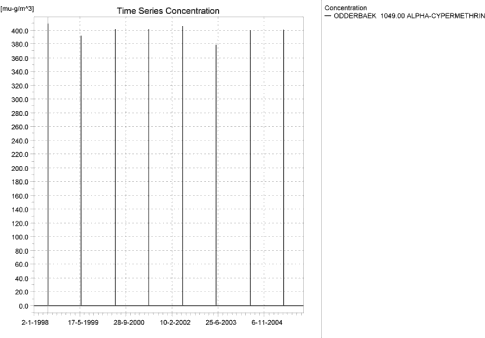
Figure 1.1. Concentration pattern over time for alphacypermethrin in the sandy catchment.
Figur 1.1. Koncentrationsmønster som funktion af tid for alpha-cypermethrin i det sandede opland.
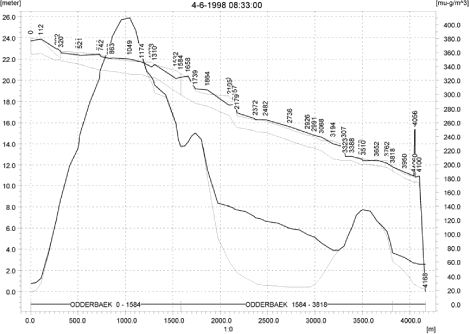
Figure 1.2. Concentrations of alpha-cypermethrin in the sandy catchment on the day of spraying 1998, just at the end of the spraying period.
Figur 1.2. Koncentrationer af alpha-cypermethrin i det sandede opland på sprøjtedagen i 1998 lige efter endt sprøjtning.
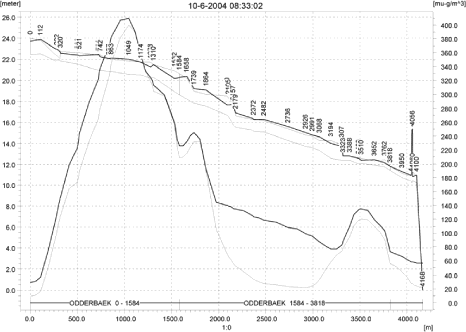
Figure 1.3. Concentrations of alpha-cypermethrin in the sandy catchment on the day of spraying 2004.
Figur 1.3. Koncentrationer af alpha-cypermethrin i det sandede opland på sprøjtedagen i 2004.
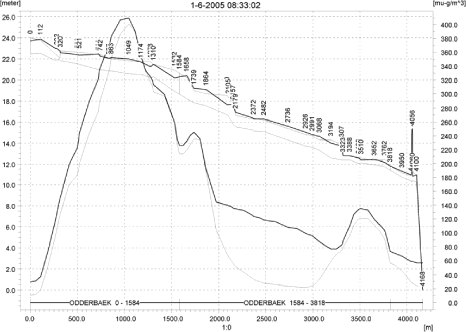
Figure 1.4. Concentrations of alpha-cypermethrin in the sandy catchment on the day of spraying 2005.
Figur 1.4. Koncentrationer af alpha-cypermethrin i det sandede opland på sprøjtedagen i 2005 lige efter endt sprøjtning.
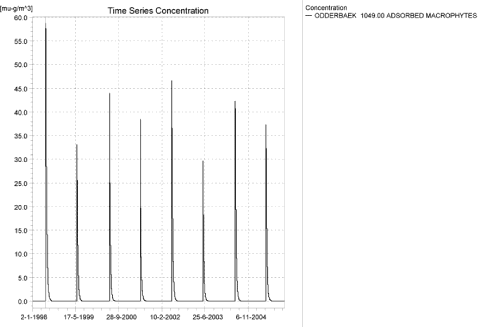
Figure 1.5. Concentration of alpha-cypermethrin on macrophytes in the point of maximum concentration in the water phase in the sandy catchment. The absolute maximum for macrophyte concentration, 59.8 ng/l, was reached further downstream (1421).
Figur 1.5. Koncentration af alpha-cypermethrin på makrofytter på lokaliteten med maximumskoncentration i vandfasen i det sandede opland. Det absolutte maximum for makrofytkoncentration, 59.8 ng/l fandtes længere nedstrøms (1421).
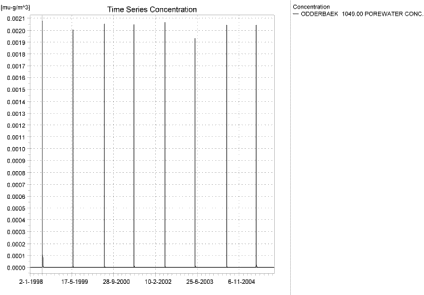
Figure 1.6. Pore water concentration for alpha-cypermethrin at the point of maximum concentration in the sandy catchment.
Figur 1.6. Porevandskoncentration for alpha-cypermethrin på lokaliteten med maximumskoncentration i det sandede opland.
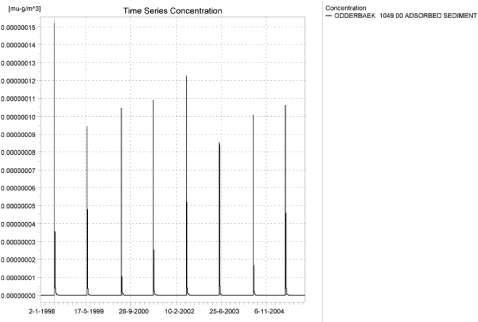
Figure 1.7. Sediment concentration for alpha-cypermethrin at the point of maximum concentration in the sandy catchment. Note that the concentration is in µg/g and not µg/m³ as stated.
Figur 1.7. Sedimentkoncentration for alpha-cypermethrin på lokaliteten med maximumskoncentration I det sandede opland. Bemærk at koncentrationen er i µg/g og ikke i µg/m³ som angivet.
Table 1.3. Actual and time-weighted concentration of alpha-cypermethrin, ng/l, at selected points in the sandy stream.
Tabel 1.3. Beregnet og tidsvægtet koncentration af alpha-cypermetrhin, ng/l, på udvalgte lokaliteter i det sandede vandløb.
| Year | ODDERBAEK 1049.00 | ODDERBAEK 1739.00 | ODDERBAEK 3499.50 | |||||||
| Conc. | TWC | Date | Conc. | TWC | Date | Conc. | TWC | Date | ||
| 1998 | (global max) | 409 | 04-06-1998 08:33 | 245 | 04-06-1998 08:33 | 135 | 04-06-1998 08:33 | |||
| 1 hour (after max) | 270 | 333 | 185 | 200 | 47 | 75 | ||||
| 1 day after sp.in. | 1 | 36 | 1 | 33 | 1 | 20 | ||||
| 2 days | 1 | 12 | 1 | 11 | 1 | 7 | ||||
| 4 days | 0 | 9 | 1 | 9 | 1 | 5 | ||||
| 7 days | 0 | 6 | 0 | 5 | 0 | 3 | ||||
| 1999 | (global max) | 392 | 01-06-1999 08:32 | 231 | 01-06-1999 08:32 | 110 | 01-06-1999 08:32 | |||
| 1 hour (after max) | 192 | 284 | 183 | 197 | 35 | 58 | ||||
| 1 day after sp.in. | 0 | 20 | 0 | 20 | 0 | 15 | ||||
| 2 days | 0 | 7 | 0 | 7 | 0 | 5 | ||||
| 4 days | 0 | 5 | 0 | 5 | 0 | 4 | ||||
| 7 days | 0 | 3 | 0 | 3 | 0 | 2 | ||||
| 2000 | (global max) | 402 | 10-06-2000 08:33 | 235 | 10-06-2000 08:33 | 121 | 10-06-2000 08:33 | |||
| 1 hour (after max) | 209 | 297 | 187 | 199 | 40 | 65 | ||||
| 1 day after sp.in. | 0 | 22 | 0 | 23 | 1 | 17 | ||||
| 2 days | 0 | 7 | 0 | 8 | 0 | 6 | ||||
| 4 days | 0 | 6 | 0 | 6 | 0 | 4 | ||||
| 7 days | 0 | 3 | 0 | 4 | 0 | 3 | ||||
| 2001 | (global max) | 402 | 01-06-2001 08:33 | 237 | 01-06-2001 08:33 | 123 | 01-06-2001 08:33 | |||
| 1 hour (after max) | 218 | 302 | 190 | 201 | 41 | 66 | ||||
| 1 day after sp.in. | 0 | 23 | 0 | 24 | 1 | 18 | ||||
| 2 days | 0 | 8 | 0 | 8 | 0 | 6 | ||||
| 4 days | 0 | 6 | 0 | 6 | 0 | 5 | ||||
| 7 days | 0 | 4 | 0 | 4 | 0 | 3 | ||||
| 2002 | (global max) | 406 | 04-06-2002 08:33 | 239 | 04-06-2002 08:33 | 124 | 04-06-2002 08:33 | |||
| 1 hour (after max) | 240 | 316 | 185 | 199 | 41 | 67 | ||||
| 1 day after sp.in. | 0 | 28 | 0 | 27 | 1 | 17 | ||||
| 2 days | 0 | 9 | 0 | 9 | 0 | 6 | ||||
| 4 days | 0 | 7 | 0 | 7 | 0 | 5 | ||||
| 7 days | 0 | 4 | 0 | 4 | 0 | 3 | ||||
| 2003 | (global max) | 379 | 01-06-2003 08:33 | 226 | 01-06-2003 08:33 | 107 | 01-06-2003 08:33 | |||
| 1 hour (after max) | 171 | 268 | 177 | 194 | 34 | 55 | ||||
| 1 day after sp.in. | 0 | 17 | 0 | 18 | 0 | 14 | ||||
| 2 days | 0 | 6 | 0 | 6 | 0 | 5 | ||||
| 4 days | 0 | 4 | 0 | 5 | 0 | 4 | ||||
| 7 days | 0 | 3 | 0 | 3 | 0 | 2 | ||||
| 2004 | (global max) | 400 | 10-06-2004 08:33 | 232 | 10-06-2004 08:33 | 120 | 10-06-2004 08:33 | |||
| 1 hour (after max) | 201 | 292 | 184 | 197 | 39 | 64 | ||||
| 1 day after sp.in. | 0 | 21 | 0 | 22 | 1 | 16 | ||||
| 2 days | 0 | 7 | 0 | 8 | 0 | 6 | ||||
| 4 days | 0 | 5 | 0 | 6 | 0 | 4 | ||||
| 7 days | 0 | 3 | 0 | 3 | 0 | 3 | ||||
| 2005 | (global max) | 401 | 01-06-2005 08:33 | 235 | 01-06-2005 08:33 | 121 | 01-06-2005 08:33 | |||
| 1 hour (after max) | 212 | 298 | 188 | 200 | 40 | 65 | ||||
| 1 day after sp.in. | 0 | 23 | 0 | 24 | 1 | 17 | ||||
| 2 days | 0 | 8 | 0 | 8 | 0 | 6 | ||||
| 4 days | 0 | 6 | 0 | 6 | 0 | 5 | ||||
| 7 days | 0 | 3 | 0 | 4 | 0 | 3 | ||||
| Global max | 409 | 245 | 135 | |||||||
| 1 hour (after max) | 270 | 333 | 190 | 201 | 47 | 75 | ||||
| 1 day after sp.in. | 1 | 36 | 1 | 33 | 1 | 20 | ||||
| 2 days | 1 | 12 | 1 | 11 | 1 | 7 | ||||
| 4 days | 0 | 9 | 1 | 9 | 1 | 5 | ||||
| 7 days | 0 | 6 | 0 | 5 | 0 | 3 | ||||
Figure 1.8. Overview for alpha cypermethrin in the sandy catchment generated by the PestSurf excel template. The max concentrations generated over 24 hours are similar to the overviews in Figure 1.2, Figure 1.3 and Figure 1.4. The graph to the lower right shows how many events have concentrations higher than a given value for the selected monitoring point. Detection value was set to 1 ng/l.
Figur 1.8. Oversigt for alpha-cypermethrin i det sandede opland genereret med PestSurf-excel-skabelonen. Den maximale koncentration genereret over 24 timer svarer til oversigterne i Figur 1.2, Figur 1.3 og Figur 1.4. Grafen nederst til højre viser hvor mange hændelser, der har koncentrationer højere end en given værdi i et udvalgt punkt. Detektionsgrænsen var sat til 1 ng/l.
Figure 1.9. Same as Figure 1.8, but with a limiting value of 10 ng/l. The graph to the lower right shows how many events (above 10 ng/l) have a duration longer than the value on the Y-axis for the selected monitoring points.
Figur 1.9. Mage til figure Figur 1.8, men med en begrænsende værdi på 10 ng/l. Grafen nederst til højre viser hvor mange hændelser (over 10 ng/l) med længere varighed end værdien på Y-aksen, der er for udvalgte lokaliteter.
Table 1.4. Part of the result sheet generated by the PestSurf Excel sheet. The selected table shows the Pre-defined point along the stream with the highest concentration recorded. The lowest detection concentration is set to 1, while the toxicity values for fish, daphnies and algae are set to 10, 100 and 1000 ng/l, respectively.
Tabel 1.4. Uddrag af resultatpresentationen genereret af PestSurf-Excel-arket. Den udvalgte tabel viser det fordefinerede punkt langs med åen med højest koncentration. Detektionsgrænsen er sat til 1 mens toxicitetsværdierne for fisk, dafnier og alger er henholdsvis 10, 100 og 1000 ng/l.
The global maximum value calculated by PestSurf for the sandy catchment in the water phase is 409 ng/l. This is 4-5 times more than what is found in the D3-ditch scenario (91 ng/l). The pesticide was sorbed to macrophytes in the stream rather than to sediment.
Figure 1.8 shows the output of the PestSurf Excel template. The template works with pre-defined data extraction points. The plot requires specification of a “lowest detection value” (ldc), which defines when a pesticide occurrence is defined as an event. The time series plot is identical to the time series shown earlier, and the graph in the upper right corner resembles the plots in Figure 1.2, Figure 1.3 and Figure 1.4, but takes into account a longer period of time. A curve is generated when a downstream point reaches a concentration higher than the ldc. The programme then tracks the highest concentration for each calculation point in the stream within the last 24 hours. The plot in the lower right corner shows how many events have concentrations higher than a given toxicity value for the selected monitoring points. The curves are rather flat, showing little variation from year to year. Figure 1.9 shows the same picture, except that the figure to the lower right shows how many events have a duration longer than a given value for the selected monitoring points. In this case an event is defined by a concentration higher than 10 ng/l. Table 1.4 shows part of the result sheet generated by the PestSurf Excel sheet based on the ldc-value. The selected table shows the point along the stream (of the pre-defined points) with the highest concentration. This value was, however, only 226 ng/l. Thus, the pre-defined points have not caught the highest concentration of the simulation, which was 409 ng/l.
1.4.2 Sandy catchment, pond
The concentration pattern is evaluated in the middle of the pond only, see Figure 1.10. The pond receives drift and a contribution from groundwater. The drift peaks dominate in all years, however in the last two years, the dry and normal weather leads to significant concentrations through the baseflow contribution. The maximum concentration is still quite low, 2.1 ng/l.
In Table 1.5, global maxima and time weighted concentrations (up to 7 days) were extracted.
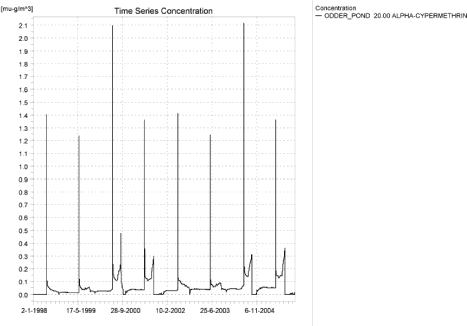
Figure 1.10. Concentrations of alpha-cypermethrin in the sandy pond.
Figur 1.10. Koncentration af alpha-cypermethrin i det sandede vandhul.
Table 1.5. Maximum actual and time-weighted concentrations of alpha-cypermethrin (ng/l) generated by drift and baseflow for the sandy pond.
Tabel 1.5. Beregnede og tidsvægtede maximumskoncentrationer af alpha-cypermethrin (ng/l) genereret af drift og grundvandstilstrømning for det sandede vandhul.
| Year | Alpha-cypermethrin | Conc | TWC | Date of occurrence |
| 1998 | Global max | 1.402 | 04-06-1998 08:30 | |
| 1 hour(after max) | 0.768 | 0.923 | ||
| 1 day after sp.in. | 0.206 | 0.349 | ||
| 2 days | 0.121 | 0.216 | ||
| 4 days | 0.107 | 0.190 | ||
| 7 days | 0.084 | 0.149 | ||
| 1999 | Global max | 1.237 | 01-06-1999 08:30 | |
| 1 hour | 0.698 | 0.826 | ||
| 1 day | 0.202 | 0.332 | ||
| 2 days | 0.118 | 0.209 | ||
| 4 days | 0.104 | 0.184 | ||
| 7 days | 0.080 | 0.144 | ||
| 2000 | Global max | 2.098 | 10-06-2000 08:30 | |
| 1 hour | 1.103 | 1.369 | ||
| 1 day | 0.307 | 0.497 | ||
| 2 days | 0.206 | 0.326 | ||
| 4 days | 0.191 | 0.293 | ||
| 7 days | 0.171 | 0.244 | ||
| 2001 | Global max | 1.360 | 01-06-2001 08:30 | |
| 1 hour | 0.764 | 0.907 | ||
| 1 day | 0.240 | 0.374 | ||
| 2 days | 0.162 | 0.250 | ||
| 4 days | 0.150 | 0.226 | ||
| 7 days | 0.138 | 0.190 | ||
| 2002 | Global max | 1.413 | 04-06-2002 08:30 | |
| 1 hour | 0.788 | 0.940 | ||
| 1 day | 0.242 | 0.380 | ||
| 2 days | 0.162 | 0.253 | ||
| 4 days | 0.149 | 0.228 | ||
| 7 days | 0.125 | 0.188 | ||
| 2003 | Global max | 1.243 | 01-06-2003 08:30 | |
| 1 hour | 0.710 | 0.836 | ||
| 1 day | 0.223 | 0.350 | ||
| 2 days | 0.141 | 0.230 | ||
| 4 days | 0.126 | 0.205 | ||
| 7 days | 0.102 | 0.165 | ||
| 2004 | Global max | 2.114 | 10-06-2004 08:30 | |
| 1 hour | 1.124 | 1.390 | ||
| 1 day | 0.334 | 0.522 | ||
| 2 days | 0.234 | 0.352 | ||
| 4 days | 0.220 | 0.321 | ||
| 7 days | 0.200 | 0.272 | ||
| 2005 | Global max | 1.364 | 01-06-2005 08:30 | |
| 1 hour | 0.772 | 0.914 | ||
| 1 day | 0.254 | 0.386 | ||
| 2 days | 0.178 | 0.264 | ||
| 4 days | 0.167 | 0.241 | ||
| 7 days | 0.156 | 0.206 | ||
| max values | ||||
| Global max | 2.114 | 0.000 | ||
| 1 hour | 1.124 | 1.390 | ||
| 1 day | 0.334 | 0.522 | ||
| 2 days | 0.234 | 0.352 | ||
| 4 days | 0.220 | 0.321 | ||
| 7 days | 0.200 | 0.272 |
The sorption to macrophytes is shown in Figure 1.11. The pattern generally follows the concentration in the water. However, concentration patterns of longer duration seem to have greater impact on the sorbed amount than the drift peaks. The concentration is specified per m³ water column. To find the value in biomass, the concentration should be divided by 33 g/m³.
The concentration of alpha-cypermethrin in porewater is shown in Figure 1.12. Here both the drift peaks and more permanent concentration patterns are visible. The concentration in sediment is below 0.01 ng/kg. Values below 0.01 ng/kg are stored as “0” in the model.
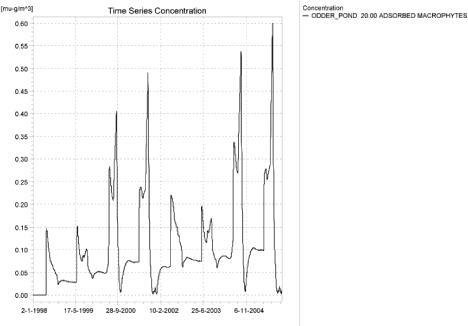
Figure 1.11. Sorption of alpha-cypermethrin to macrophytes in the sandy pond.
Figur 1.11. Sorption af alpha-cypermethrin til makrofytter i det sandede vandhul.
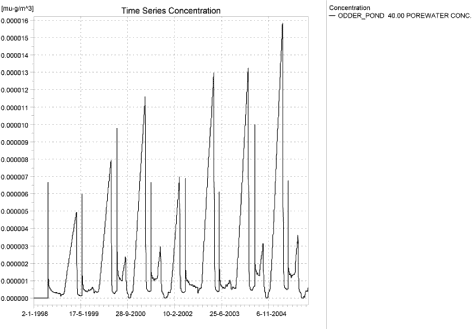
Figure 1.12. Pore water concentration of alpha-cypermethrin in the sandy pond.
Figur 1.12. Porevandskoncentration af alpha/cypermetrin i det sandede vandhul.
Figure 1.12 shows the output of the PestSurf Excel template. The template works with one pre-defined data extraction point for the pond (center of the pond). The plot requires specification of a “lowest detection value” (ldc) which defines when a pesticide occurrence is defined as an event. The time series plot is identical to the time series shown earlier. The plot to the right shows how many events have concentrations higher than a given toxicity value for the selected monitoring points.
Table 1.6 shows part of the result sheet generated by the PestSurf Excel sheet based on the ldc-value.
Click here to see Figure 1.13.
Figure 1.13. Overview for alpha cypermethrin in the sandy pond generated by the PestSurf excel template. The time series shown is identical to the one in Figure 1.10. Lowest detection value is set to 0.05 ng/l.
Figur 1.13. Oversigt for alpha-cypermethrin i det sandede vandhul genereret med PestSurf-excel-skabelonen. Den viste tidsserie er mage til den i Figur 1.10 Detektionsgrænsen er sat til 0.05 ng/l.
Table 1.6. Part of the result sheet generated by the PestSurf Excel sheet. The lowest detection value is 0.05 ng/l, toxicity to fish, daphnies and algae are 1, 10 and 100 ng/, respectively. The recorded peaks are shown in Figure 1.13.
Tabel 1.6. Uddrag af resultatpresentationen genereret af PestSurf-Excel-arket. Detektionsgrænsen er sat til 0.05 ng/l mens toxicitetsværdierne for fisk, dafnier og alger er henholdsvis 10, 100 og 1000 ng/l. De tabellerede hændelser er vist i Figur 1.13.
1.4.3 Sandy Loam catchment, stream
The distribution of concentrations were assessed in several steps. First, the maximum concentrations at each calculation point were listed, and the dates for the occurrence of the maximum was assessed (Table 1.7). The points, for which the maximum value also represents a local maximum, were selected for further analysis.
Table 1.7. Maximum concentrations (ng/l) of alpha-cypermethrin simulated for each calculation point in the Sandy loam catchment.
Tabel 1.7. Maximumskoncentrationer (ng/l) af alpha-cypermethrin simuleret for hvert beregningspunkt i morænelersoplandet.
| ALPHA-CYPERMETHRIN | Maximum | Max.Time | Local maxima |
| ALBJERGBAEK 0.00 | 0.04 | 23-10-1998 00:00 | |
| ALBJERGBAEK 150.00 | 0.08 | 26-10-1998 00:00 | |
| ALBJERGBAEK 300.00 | 0.32 | 31-05-1998 09:10 | |
| ALBJERGBAEK 450.00 | 0.06 | 26-10-1998 00:00 | |
| ALBJERGBAEK 600.00 | 176.68 | 31-05-2001 10:00 | |
| ELHOLTBAEK 0.00 | 0.43 | 31-05-1999 09:10 | |
| ELHOLTBAEK 165.00 | 0.00 | 01-06-1994 08:10 | |
| ELHOLTBAEK 330.00 | 273.35 | 31-05-2000 08:49 | |
| FREDLIGBAEK 0.00 | 0.06 | 18-09-1998 00:00 | |
| FREDLIGBAEK 100.00 | 0.09 | 18-09-1998 00:00 | |
| FREDLIGBAEK 200.00 | 0.09 | 18-09-1998 00:00 | |
| FREDLIGBAEK 300.00 | 0.09 | 18-09-1998 00:00 | |
| FREDLIGBAEK 400.00 | 0.10 | 18-09-1998 00:00 | |
| FREDLIGBAEK 500.00 | 0.06 | 31-10-1998 00:00 | |
| FREDLIGBAEK 600.00 | 0.27 | 31-05-1998 09:00 | |
| FREDLIGBAEK 667.50 | 0.58 | 25-08-1998 00:00 | |
| FREDLIGBAEK 735.00 | 461.11 | 31-05-2001 09:00 | |
| GROFTEBAEK 0.00 | 0.05 | 24-09-1998 00:00 | |
| GROFTEBAEK 155.00 | 103.78 | 09-10-2001 00:00 | |
| GROFTEBAEK 310.00 | 77.88 | 10-10-2001 00:00 | |
| GROFTEBAEK 465.00 | 130.50 | 09-10-2001 00:00 | |
| GROFTEBAEK 620.00 | 599.20 | 31-05-2000 09:00 | |
| STENSBAEK 0.00 | 0.05 | 13-02-2001 00:00 | |
| STENSBAEK 125.00 | 1.39 | 18-09-1998 00:00 | |
| STENSBAEK 250.00 | 0.86 | 18-09-1998 00:00 | |
| STENSBAEK 412.50 | 1.56 | 18-09-1998 00:00 | |
| STENSBAEK 575.00 | 55.49 | 31-05-2000 12:00 | |
| OVRELILLEBAEK 0.00 | 0.06 | 30-10-1998 00:00 | |
| OVRELILLEBAEK 125.00 | 517.89 | 31-05-1998 08:30 | |
| OVRELILLEBAEK 250.00 | 545.78 | 31-05-2000 08:30 | |
| OVRELILLEBAEK 290.00 | 606.65 | 31-05-1999 08:40 | X |
| OVRELILLEBAEK 330.00 | 176.68 | 31-05-2001 10:00 | |
| OVRELILLEBAEK 330.00 | 176.68 | 31-05-2001 10:00 | |
| OVRELILLEBAEK 352.50 | 362.80 | 31-05-2000 08:30 | |
| OVRELILLEBAEK 375.00 | 55.49 | 31-05-2000 12:00 | |
| OVRELILLEBAEK 375.00 | 55.49 | 31-05-2000 12:00 | |
| OVRELILLEBAEK 437.50 | 328.90 | 31-05-2000 08:30 | |
| OVRELILLEBAEK 500.00 | 526.19 | 31-05-2000 08:30 | |
| OVRELILLEBAEK 625.00 | 569.25 | 31-05-2000 08:30 | |
| OVRELILLEBAEK 750.00 | 419.73 | 31-05-2000 08:30 | |
| OVRELILLEBAEK 855.00 | 583.35 | 31-05-2000 08:30 | |
| OVRELILLEBAEK 960.00 | 273.35 | 31-05-2000 08:49 | |
| OVRELILLEBAEK 960.00 | 273.35 | 31-05-2000 08:49 | |
| OVRELILLEBAEK 980.00 | 292.71 | 31-05-2000 09:00 | |
| OVRELILLEBAEK 1000.00 | 220.82 | 31-05-2000 09:00 | |
| OVRELILLEBAEK 1062.50 | 230.55 | 31-05-2000 08:30 | |
| OVRELILLEBAEK 1125.00 | 336.54 | 31-05-2000 08:30 | |
| OVRELILLEBAEK 1187.50 | 463.80 | 31-05-2000 08:30 | |
| OVRELILLEBAEK 1250.00 | 478.96 | 31-05-2000 08:30 | |
| OVRELILLEBAEK 1425.00 | 559.99 | 31-05-2000 08:30 | X |
| OVRELILLEBAEK 1600.00 | 425.42 | 31-05-2000 08:30 | |
| OVRELILLEBAEK 1650.00 | 513.32 | 31-05-2000 08:30 | |
| OVRELILLEBAEK 1700.00 | 249.63 | 31-05-2001 08:49 | |
| NEDRELILLEBAEK 0.00 | 249.63 | 31-05-2001 08:49 | |
| NEDRELILLEBAEK 135.00 | 334.18 | 31-05-2000 08:30 | |
| NEDRELILLEBAEK 270.00 | 557.08 | 01-06-1996 08:30 | |
| NEDRELILLEBAEK 330.00 | 624.79 | 31-05-2000 08:30 | X |
| NEDRELILLEBAEK 390.00 | 573.84 | 31-05-2000 08:30 | |
| NEDRELILLEBAEK 495.50 | 656.80 | 31-05-2001 08:30 | X |
| NEDRELILLEBAEK 601.00 | 461.11 | 31-05-2001 09:00 | |
| NEDRELILLEBAEK 601.00 | 461.11 | 31-05-2001 09:00 | |
| NEDRELILLEBAEK 693.00 | 511.93 | 31-05-2000 08:30 | |
| NEDRELILLEBAEK 785.00 | 813.02 | 31-05-2000 08:30 | |
| NEDRELILLEBAEK 847.00 | 1065.24 | 31-05-2000 08:30 | X |
| NEDRELILLEBAEK 909.00 | 599.20 | 31-05-2000 09:00 | |
| NEDRELILLEBAEK 909.00 | 599.20 | 31-05-2000 09:00 | |
| NEDRELILLEBAEK 984.50 | 499.83 | 31-05-2000 09:19 | |
| NEDRELILLEBAEK 1060.00 | 924.80 | 31-05-2000 08:30 | |
| NEDRELILLEBAEK 1169.50 | 1073.28 | 31-05-2000 08:30 | |
| NEDRELILLEBAEK 1279.00 | 1355.24 | 31-05-2000 08:40 | X |
| NEDRELILLEBAEK 1409.50 | 634.51 | 31-05-2001 08:49 | |
| NEDRELILLEBAEK 1540.00 | 345.15 | 31-05-1998 09:10 | |
| Global max | 1355.24 |
All over the catchment, the wind drift contribution dominates. In the upper part of the catchment, only drift peaks are visible on Figure 1.14. In the downstream part of the system (Figure 1.15), winddrift still dominates, but a contribution through the groundwater (reaching the stream system via drains) can be seen. The concentrations build up over the 8 years simulated and become significant at the end of the summer of 2000 and 2001 (corresponding to a very dry year and a normal year, respectively). During these periods, the flow in the stream consists of base flow contributions through drain only. The downstream tributaries, Fredligbaek and Groeftebaek show exactly the same picture as the downstream part of stream with respect to groundwater buildup.
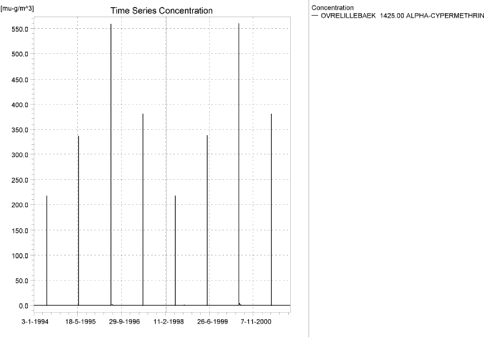
Figure 1.14. Typical concentration pattern as a function of time for alpha-cypermethrin in the upstream end of the sandy loam catchment.
Figur 1.14. Typisk koncentrationsmønster som funktion af tid for alpha-cypermethrin i den opstrøms ende af morænelersoplandet.
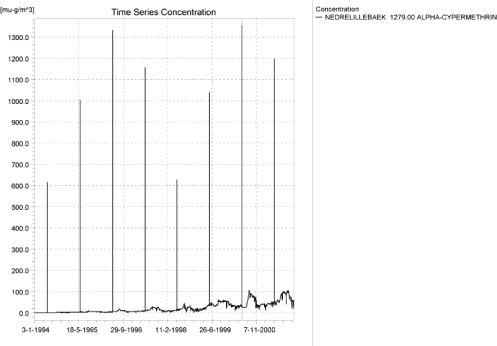
Figure 1.15. Typical concentration pattern in the downstream end of the sandy loam catchment. The wind drift events dominates, but a groundwater contribution is visible.
Figur 1.15. Typisk koncentrationsmønster i den nedstrøms ende af morænelersoplandet. Vinddriften dominerer, men grundvandstilstrømning kan ses.
Longitudinal concentration profiles for the sandy loam catchment are shown in Figure 1.16 and Figure 1.17 for 31. May 2000 and 27th August 2000, respectively. The thin black line represents the concentration, while full black line shows the maximum concentrations obtained during the simulations. In addition, the outline of the stream is shown.
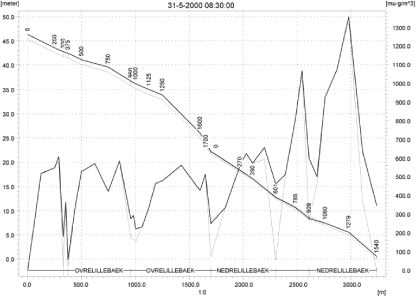
Figure 1.16. Concentrations in the sandy loam catchment on 31 May-2000. The concentrations are generated by wind drift. Note that the actual concentrations are shown with a thin black line and the maximum concentrations with a thicker black line.
Figur 1.16. Koncentrationer i morænelersoplandet den 31 maj-2000. Koncentrationerne genereres af vinddrift. Bemærk at den beregnede koncentration er vist med en tynd sort linie og maximumskoncentrationen med en tykkere sort linie.
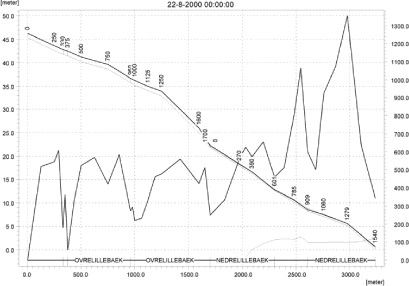
Figure 1.17. Concentrations caused by an increase of alpha-cypermethrin in the groundwater in the sandy loam catchment on 22.8-2000 (dry year).
Figur 1.17. Koncentrationer begrundet af alpha-cypermetrin i grundvandet i morænelersoplandet den 22.8-2000 (tørt år).
It is generally thought that the model overestimates the transport to groundwater, and, as a consequence of this, it overestimates the contribution through groundwater flow. The particularly high level of baseflow in the lower part of this catchment is due to occurrence of a sandy layer that transports solute horizontally through the catchment to the lower part of the stream.
To be able to extract comparable values to FOCUS SW, the global maxima and time weighted concentrations (up to 7 days) were extracted when these were meaningful (Table 1.8).
Figure 1.18 and Figure 1.19 shows the concentrations sorbed to macrophytes in the upper and lower section of the stream. The pattern follows the pattern of the water concentrations, but the more permanent patterns seem to have the largest influence on the macrophyt concentration. The concentrations are very high compared to the concentration in the water phase, particularly in the lower end of the catchment. The maximum value obtained in the upstream part is 617 ng/l, comparable to the maximum water concentration of 607 ng/l, and in the lower part, the concentration reaches 6.2 µg/l (Nedrelillebaek 847, with a maximum water concentration of 1.07 µg/l). This value is caused by the unrealistic buildup in the groundwater downstream. Macrophytes thus strongly regulate the concentration in the stream.
The concentration of alpha-cypermethrin in porewater is plotted in Figure 1.20 for the site of maximum concentration, and the concentration in sediment is shown in Figure 1.21. The maximum value reached in the upstream part of the catchment is from below 0.01 ng/kg to 0.12 ng/kg. In the downstream part a maximum value of 1.36 ng/kg is reached.
Compared to the FOCUS SW-stream-scenario for D4, the concentration level in the upper part of the stream is considerably higher (583 ng/l compared to 79 ng/l). Both concentrations are generated by drift. The high value of PestSurf is directly caused by the assumption that the total agricultural area is sprayed within 30 minutes. The stream has received drift along a stretch of 855 meter at this point. Concentrations decrease along the following stretch due to presence of buffer zones and drain contributions, but increases again at the end of the catchment due to direct drift, reaching a maximum value of 1.4 µg/l.
With respect to sediment concentrations, the concentration vary over the catchment - in the upstream part (<0.01 ng/kg-0.14 ng/kg compared to 0.119 µg/kg in the D4-scenario), and in the lower part of the catchment (1.36 ng/kg compared to 0.119 µg/kg). All sediment concentrations generated by PestSurf are lower than the concentrations generated by FOCUS.
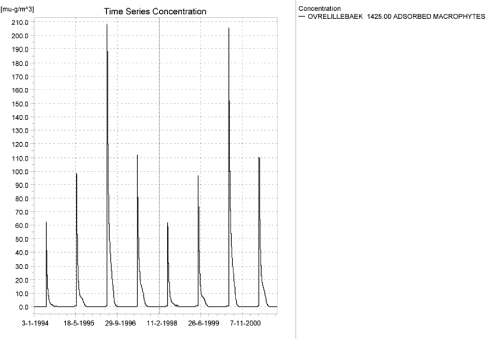
Figure 1.18. Concentration of alpha-cypermethrin on macrophytes in ng/l at 1425 m from the upstream point. The pattern is representative of the upper part of the sandy loam catchment.
Figur 1.18. Koncentration af alpha-cypermethrin på makrofytter 1425 m fra opstrøms ende. Mønsteret er repræsentativt for den øvre del af morænelersoplandet.
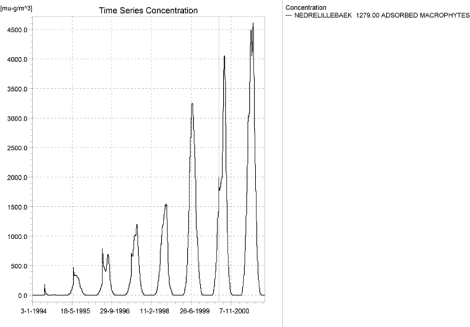
Figure 1.19. Concentration on macrophytes (ng/l) the lower part of the sandy loam stream. The pattern is representative of the lower part of the sandy loam catchment. The highest value reached is 6157 ng/l.
Figur 1.19. Koncentration på makrofytter i den nedstrøms del af morænelersoplandet. Mønsteret er repræsentativt for den nedstrøms del af oplandet. Den højest opnåede værdi er 6157 ng/l.
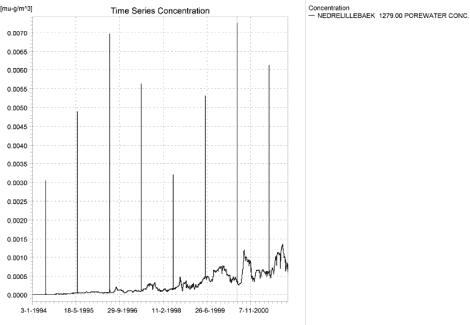
Figure 1.20. Pore water concentration in the downstream part of the sandy loam catchment.
Figur 1.20. Porevandskoncentration i den nedstrøms del af morænelersoplandet.
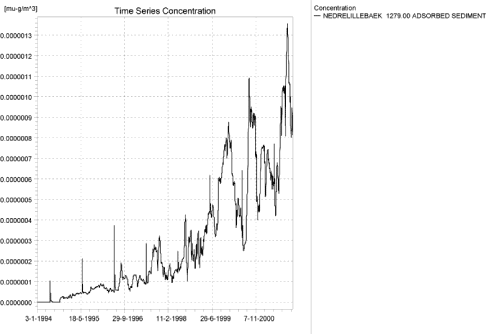
Figure 1.21. Concentration pattern of alpha cypermethrin sorbed to sediment at the downstream part of the sandy loam catchment. The concentration is in µg/g sediment and not µg/m³ as stated.
Figur 1.21. Koncentrationsmønster for alpha-cypermethrin sorberet til sediment i den nedstrøms ende af morænelersoplandet. Koncentrationen er i µg/g sediment og ikke µg/m³ som angivet.
Table 1.8. Instantaneous and time weighted concentrations (ng/l) of alpha-cypermethrin in the sandy loam catchment.
Tabel 1.8. Beregnet og tidsvægtede koncentrationer (ng/l) af alpha-cypermethrin i morænelersoplandet.
| Year | OVRELILLEBAEK 290.00 | OVRELILLEBAEK 1425.00 | NEDRELILLEBAEK 330.00 | NEDRELILLEBAEK 495.50 | |||||||||
| Conc. | TWC | Date | Conc | TWC | Date | Conc. | TWC | Date | Conc. | TWC | Date | ||
| 1994 | 1994 (global max) | 537 | 01-06-1994 | 217 | 01-06-1994 | 314 | 01-06-1994 | 436 | 01-06-1994 | ||||
| 1 hour (after max) | 154 | 321 | 92 | 132 | 91 | 182 | 117 | 226 | |||||
| 1 day after sp.in. | 2 | 26 | 0 | 7 | 0 | 11 | 0 | 13 | |||||
| 2 days | 2 | 10 | 0 | 2 | 0 | 4 | 0 | 4 | |||||
| 4 days | 2 | 8 | 0 | 2 | 0 | 3 | 0 | 3 | |||||
| 7 days | 1 | 5 | 0 | 1 | 0 | 2 | 0 | 2 | |||||
| 1995 | 1995 (global max) | 605 | 01-06-1995 | 337 | 01-06-1995 | 472 | 01-06-1995 | 625 | 01-06-1995 | ||||
| 1 hour (after max) | 407 | 517 | 136 | 183 | 197 | 267 | 156 | 371 | |||||
| 1 day after sp.in. | 4 | 58 | 0 | 11 | 1 | 17 | 4 | 25 | |||||
| 2 days | 3 | 21 | 0 | 4 | 1 | 6 | 4 | 11 | |||||
| 4 days | 3 | 17 | 0 | 3 | 1 | 5 | 4 | 9 | |||||
| 7 days | 3 | 11 | 0 | 2 | 1 | 3 | 4 | 7 | |||||
| 1996 | 1996 (global max) | 583 | 01-06-1996 | 559 | 01-06-1996 | 621 | 01-06-1996 | 589 | 01-06-1996 | ||||
| 1 hour (after max) | 520 | 555 | 141 | 359 | 259 | 460 | 474 | 553 | |||||
| 1 day after sp.in. | 8 | 87 | 1 | 26 | 3 | 37 | 7 | 52 | |||||
| 2 days | 7 | 33 | 1 | 10 | 2 | 14 | 7 | 22 | |||||
| 4 days | 7 | 27 | 1 | 7 | 2 | 11 | 7 | 18 | |||||
| 7 days | 6 | 18 | 1 | 5 | 2 | 7 | 6 | 13 | |||||
| 1997 | 1997 (global max) | 597 | 01-06-1997 | 380 | 01-06-1997 | 516 | 01-06-1997 | 641 | 01-06-1997 | ||||
| 1 hour (after max) | 479 | 547 | 137 | 206 | 215 | 277 | 184 | 446 | |||||
| 1 day after sp.in. | 6 | 65 | 1 | 13 | 2 | 20 | 7 | 32 | |||||
| 2 days | 6 | 25 | 1 | 5 | 2 | 7 | 8 | 16 | |||||
| 4 days | 6 | 20 | 1 | 4 | 2 | 6 | 8 | 14 | |||||
| 7 days | 5 | 14 | 0 | 2 | 2 | 4 | 8 | 11 | |||||
| 1998 | 1998 (global max) | 538 | 31-05-1998 | 218 | 31-05-1998 | 315 | 31-05-1998 | 445 | 31-05-1998 | ||||
| 1 hour (after max) | 156 | 323 | 92 | 132 | 92 | 184 | 127 | 235 | |||||
| 1 day after sp.in. | 2 | 26 | 0 | 7 | 1 | 11 | 9 | 21 | |||||
| 2 days | 2 | 10 | 0 | 2 | 1 | 5 | 10 | 13 | |||||
| 4 days | 2 | 8 | 0 | 2 | 1 | 4 | 10 | 12 | |||||
| 7 days | 1 | 5 | 0 | 1 | 1 | 3 | 11 | 11 | |||||
| 1999 | 1999 (global max) | 607 | 31-05-1999 | 337 | 31-05-1999 | 475 | 31-05-1999 | 654 | 31-05-1999 | ||||
| 1 hour (after max) | 411 | 519 | 137 | 184 | 202 | 271 | 185 | 400 | |||||
| 1 day after sp.in. | 4 | 58 | 0 | 11 | 5 | 20 | 31 | 50 | |||||
| 2 days | 3 | 21 | 0 | 4 | 4 | 9 | 27 | 36 | |||||
| 4 days | 3 | 17 | 0 | 3 | 4 | 8 | 26 | 33 | |||||
| 7 days | 3 | 11 | 0 | 2 | 4 | 6 | 27 | 30 | |||||
| 2000 | 2000 (global max) | 584 | 31-05-2000 | 560 | 31-05-2000 | 625 | 31-05-2000 | 612 | 31-05-2000 | ||||
| 1 hour (after max) | 506 | 551 | 142 | 361 | 263 | 464 | 446 | 559 | |||||
| 1 day after sp.in. | 8 | 88 | 1 | 26 | 5 | 40 | 28 | 73 | |||||
| 2 days | 7 | 34 | 1 | 10 | 5 | 16 | 28 | 42 | |||||
| 4 days | 7 | 27 | 1 | 8 | 5 | 13 | 28 | 39 | |||||
| 7 days | 6 | 18 | 1 | 5 | 4 | 10 | 28 | 34 | |||||
| 2001 | 2001 (global max) | 599 | 31-05-2001 | 381 | 31-05-2001 | 518 | 31-05-2001 | 657 | 31-05-2001 | ||||
| 1 hour (after max) | 451 | 535 | 138 | 206 | 218 | 280 | 200 | 463 | |||||
| 1 day after sp.in. | 6 | 66 | 1 | 13 | 3 | 21 | 22 | 47 | |||||
| 2 days | 6 | 25 | 1 | 5 | 3 | 9 | 24 | 31 | |||||
| 4 days | 6 | 20 | 1 | 4 | 4 | 8 | 25 | 29 | |||||
| 7 days | 5 | 14 | 0 | 2 | 4 | 6 | 27 | 28 | |||||
| Global max | 607 | 0 | 560 | 0 | 625 | 0 | 657 | 0 | |||||
| 1 hour (after max) | 520 | 555 | 142 | 361 | 263 | 464 | 474 | 559 | |||||
| 1 day after sp.in. | 8 | 88 | 1 | 26 | 5 | 40 | 31 | 73 | |||||
| 2 days | 7 | 34 | 1 | 10 | 5 | 16 | 28 | 42 | |||||
| 4 days | 7 | 27 | 1 | 8 | 5 | 13 | 28 | 39 | |||||
| 7 days | 6 | 18 | 1 | 5 | 4 | 10 | 28 | 34 | |||||
Table 1.8. continued. Instantaneous and time weighted concentrations (ng/l) of alpha-cypermethrin in the sandy loam catchment.
Tabel 1.8. fortsat. Beregnet og tidsvægtede koncentrationer (ng/l) af alpha-cypermethrin i morænelersoplandet.
| Year | NEDRELILLEBAEK 847.00 | NEDRELILLEBAEK 1279.00 | |||||
| Conc. | TWC | Date | Conc | TWC | Date | ||
| 1994 | 1994 (global max) | 408 | 01-06-1994 | 614 | 01-06-1994 | ||
| 1 hour (after max) | 177 | 289 | 188 | 281 | |||
| 1 day after sp.in. | 1 | 16 | 1 | 20 | |||
| 2 days | 1 | 6 | 1 | 7 | |||
| 4 days | 1 | 4 | 1 | 5 | |||
| 7 days | 0 | 3 | 1 | 3 | |||
| 1995 | 1995 (global max) | 692 | 01-06-1995 | 1002 | 01-06-1995 | ||
| 1 hour (after max) | 392 | 365 | 223 | 505 | |||
| 1 day after sp.in. | 5 | 32 | 5 | 36 | |||
| 2 days | 5 | 14 | 5 | 15 | |||
| 4 days | 5 | 12 | 5 | 12 | |||
| 7 days | 5 | 9 | 5 | 9 | |||
| 1996 | 1996 (global max) | 1039 | 01-06-1996 | 1331 | 01-06-1996 | ||
| 1 hour (after max) | 249 | 708 | 474 | 940 | |||
| 1 day after sp.in. | 9 | 62 | 8 | 70 | |||
| 2 days | 9 | 26 | 8 | 28 | |||
| 4 days | 8 | 22 | 7 | 23 | |||
| 7 days | 8 | 16 | 7 | 16 | |||
| 1997 | 1997 (global max) | 805 | 01-06-1997 | 1154 | 01-06-1997 | ||
| 1 hour (after max) | 371 | 356 | 290 | 614 | |||
| 1 day after sp.in. | 10 | 41 | 10 | 45 | |||
| 2 days | 10 | 20 | 10 | 21 | |||
| 4 days | 10 | 18 | 10 | 18 | |||
| 7 days | 10 | 14 | 10 | 15 | |||
| 1998 | 1998 (global max) | 420 | 31-05-1998 | 627 | 31-05-1998 | ||
| 1 hour (after max) | 190 | 303 | 202 | 294 | |||
| 1 day after sp.in. | 14 | 29 | 13 | 33 | |||
| 2 days | 14 | 19 | 14 | 20 | |||
| 4 days | 14 | 18 | 14 | 18 | |||
| 7 days | 15 | 16 | 14 | 16 | |||
| 1999 | 1999 (global max) | 734 | 31-05-1999 | 1038 | 31-05-1999 | ||
| 1 hour (after max) | 436 | 408 | 259 | 541 | |||
| 1 day after sp.in. | 46 | 69 | 39 | 68 | |||
| 2 days | 44 | 53 | 38 | 48 | |||
| 4 days | 43 | 51 | 37 | 46 | |||
| 7 days | 44 | 48 | 39 | 42 | |||
| 2000 | 2000 (global max) | 1065 | 31-05-2000 | 1355 | 31-05-2000 | ||
| 1 hour (after max) | 274 | 735 | 380 | 876 | |||
| 1 day after sp.in. | 33 | 87 | 29 | 91 | |||
| 2 days | 33 | 51 | 27 | 48 | |||
| 4 days | 33 | 46 | 26 | 43 | |||
| 7 days | 32 | 40 | 25 | 35 | |||
| 2001 | 2001 (global max) | 847 | 31-05-2001 | 1197 | 31-05-2001 | ||
| 1 hour (after max) | 415 | 399 | 332 | 657 | |||
| 1 day after sp.in. | 54 | 84 | 53 | 87 | |||
| 2 days | 53 | 63 | 54 | 63 | |||
| 4 days | 52 | 60 | 52 | 61 | |||
| 7 days | 49 | 56 | 48 | 56 | |||
| Global max | 1065 | 0 | 1355 | 0 | |||
| 1 hour (after max) | 436 | 735 | 474 | 940 | |||
| 1 day after sp.in. | 54 | 87 | 53 | 91 | |||
| 2 days | 53 | 63 | 54 | 63 | |||
| 4 days | 52 | 60 | 52 | 61 | |||
| 7 days | 49 | 56 | 48 | 56 | |||
Click here to see Figure 1.22.
Figure 1.22. Overview for alpha-cypermethrin in the sandy loam catchment generated by the PestSurf excel template for the upstream part of the catchment. The limiting value was set to 1 ng/l.
Figur 1.22. Oversigt for alpha-cypermethrin i morænelersoplandet genereret med PestSurf-excel-skabelonen for den opstrøms del af oplandet. Detektionsgrænsen var sat til 1 ng/l.
Click here to see Figure 1.232.
Figure 1.23. Overview for alpha-cypermethrin in the sandy loam catchment generated by the PestSurf excel template for the downstream part of the catchment. The limiting value was set to 20 ng/l.
Figur 1.23. Oversigt for alpha-cypermethrin i morænelersoplandet genereret med PestSurf-excel-skabelonen for den opstrøms del af oplandet. Detektionsgrænsen var sat til 1 ng/l.
Click here to see Figure 1.24.
Figure 1.24. As Figure 1.23, but the lower right figure shows the duration of events above 50 ng/l.
Figur 1.24. Som Figur 1.23, men figuren nederst til højre viser varigheden af hændelser over 50 ng/l.
Table 1.9. Part of the result sheet generated by the PestSurf Excel sheet for the upstream part of the sandy loam catchment. 10 events above 1 ng/l are recorded, all with a very short duration. Toxicity to fish, daphnies and algae are 10, 100 and 1000 ng/, respectively. The peaks are shown in Figure 1.22.
Tabel 1.9. Uddrag af resultatpresentationen genereret af PestSurf-Excel-arket for den opstrøms del af morænelersoplandet. 10 hændelser over 1 ng/l er registreret, alle af kort varighed. Toxicitetsværdierne for fisk, dafnier og alger er henholdsvis 10, 100 og 1000 ng/l. Hændelserne er vist i Figur 1.22.
Table 1.10. Part of the results generated by the PestSurf Excel sheet for the downstream part of the sandy loam catchment. The limiting value applied in the simulation is 20 ng/l, toxicity to fish, daphnies and algae are set to 50, 100 and 1000 ng/, respectively. The peaks are shown in Figure 1.23.
Tabel 1.10. Uddrag af resultatpresentationen genereret af PestSurf-Excel-arket for den nedstrøms del af morænelersoplandet. Den afgrænsende værdi anvendt i simuleringen er 20 ng/l, toxicitetsværdierne for fisk, dafnier og alger er henholdsvis 50, 100 og 1000 ng/l. Hændelserne er vist i Figur 1.22.
Figure 1.22-Figure 1.24, and Table 1.9 and Table 1.10 show the results as generated by the PestSurf templates. For the upper part of the catchment, one of the standard points is close to the point of maximum value, reaching a value of 513 ng/l compared to the maximum value of 560 ng/l. For the lower part of the stream, one of the selected standard points reach the maximum value of 1.36 µg/l.
1.4.4 Sandy Loam catchment, pond
The concentration pattern is evaluated in the middle of the pond only, see Figure 1.25. The pond receives contributions mainly through drift, in good correspondence with the fact that it is situated in the upper part of the sandy loam catchment. The maximum concentration is quite low, 5 ng/l.
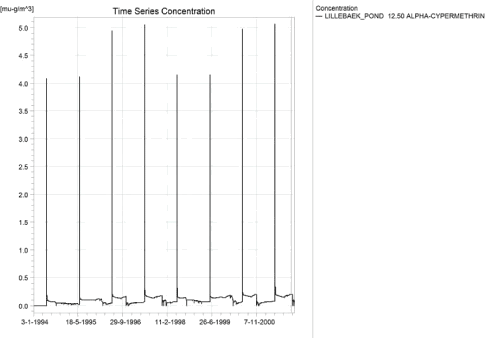
Figure 1.25. Concentrations of alpha-cypermethrin for the sandy loam pond.
Figur 1.25. Koncentration af alpha-cypermethrin i morænelersvandhullet.
Figure 1.26 shows that the macrophytes participate in the regulation of the concentrations in the pond. The concentration in macrophytes is expressed as concentration in the water phase and the concentration in the water phase and in the macrophytes are therefore comparable. About 2/3 of the alpha cypermethrin present above the sediment is present on the macrophytes. To obtain the concentration in the biomass, the figure has to be divided by 875 g/m³. Figure 1.27 shows the concentration in porewater. It is minute in comparison (1.32 *10-5 ng/l), and the concentrations in the sediment is below 0.01 ng/kg.
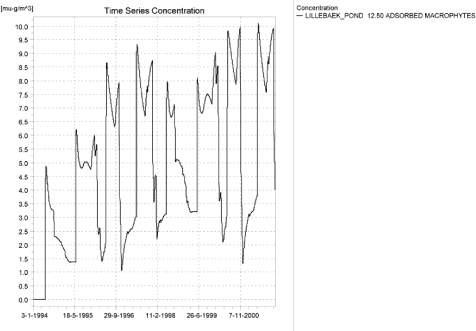
Figure 1.26. Alpha-cypermethrin sorbed to the macrophytes in the sandy loam pond.
Figur 1.26. Alpha-cypermethrin sorberet til makrofytter i morænelers-vandhullet.
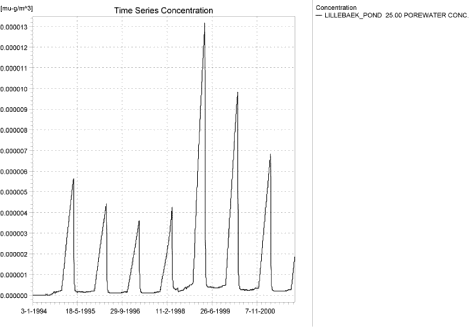
Figure 1.27. Pore water concentration of alpha-cypermethrin in the sandy loam pond.
Figur 1.27. Porevandskoncentration af alpha-cypermethrin i morænelersvandhullet.
In Table 1.11, global maxima and time weighted concentrations (up to 7 days) were extracted.
Table 1.11. Actual and time weighted concentrations (ng/l) of alpha-cypermethrin in the sandy loam pond.
Tabel 1.11. Beregnede og tidsvægtede koncentrationer (ng/l) af alpha-cypermethrin i morænelersvandhullet.
| Year | Alpha-cypermethrin | Actual | Time-weighted | Date |
| 1994 | global max | 4.09 | 01-06-1994 08:30 | |
| 1 hour(after max) | 2.15 | 2.85 | ||
| 1 day after sp.in. | 0.23 | 0.63 | ||
| 3 days | 0.12 | 0.31 | ||
| 4 days | 0.11 | 0.26 | ||
| 7 days | 0.10 | 0.19 | ||
| 1995 | Global max | 4.12 | 01-06-1995 08:30 | |
| 1 hour | 2.18 | 2.88 | ||
| 1 day | 0.26 | 0.66 | ||
| 2 days | 0.15 | 0.34 | ||
| 4 days | 0.14 | 0.29 | ||
| 7 days | 0.13 | 0.22 | ||
| 1996 | global max | 4.95 | 01-06-1996 08:30 | |
| 1 hour | 2.41 | 3.27 | ||
| 1 day | 0.35 | 0.78 | ||
| 2days | 0.21 | 0.43 | ||
| 4 days | 0.20 | 0.37 | ||
| 7 (6*)days | 0.19 | 0.29 | ||
| 1997 | global max | 5.05 | 01-06-1997 08:30 | |
| 1 hour | 2.45 | 3.33 | ||
| 1 day | 0.37 | 0.81 | ||
| 2days | 0.22 | 0.44 | ||
| 4 days | 0.21 | 0.39 | ||
| 7 (6*)days | 0.20 | 0.31 | ||
| 1998 | global max | 4.15 | 31-05-1998 08:30 | |
| 1 hour | 2.21 | 2.91 | ||
| 1 day | 0.30 | 0.69 | ||
| 2 days | 0.18 | 0.37 | ||
| 4 days | 0.17 | 0.32 | ||
| 7 (6*)days | 0.16 | 0.26 | ||
| 1999 | global max | 4.15 | 31-05-1999 08:30 | |
| 1 hour | 2.21 | 2.92 | ||
| 1 day | 0.30 | 0.69 | ||
| 2 days | 0.19 | 0.38 | ||
| 4 days | 0.18 | 0.33 | ||
| 7 (6*)days | 0.17 | 0.26 | ||
| 2000 | global max | 4.97 | 31-05-2000 08:30 | |
| 1 hour | 2.44 | 3.30 | ||
| 1 day | 0.37 | 0.81 | ||
| 2 days | 0.24 | 0.45 | ||
| 4 days | 0.22 | 0.40 | ||
| 7 (6*)days | 0.21 | 0.32 | ||
| 2001 | global max | 5.06 | 31-05-2001 08:30 | |
| 1 hour | 2.46 | 3.34 | ||
| 1 day | 0.38 | 0.82 | ||
| 2 days | 0.24 | 0.46 | ||
| 4 days | 0.22 | 0.40 | ||
| 7 (6*)days | 0.21 | 0.32 | ||
| max values | ||||
| global max | 5.06 | 0.00 | ||
| 1 hour | 2.46 | 3.34 | ||
| 1 day | 0.38 | 0.82 | ||
| 2 days | 0.24 | 0.46 | ||
| 4 days | 0.22 | 0.40 | ||
| 7 days | 0.21 | 0.32 |
Figure 1.28 and Table 1.12 show the output from the PestSurf template (page- lowest detection limit), with a time series identical to Figure 1.25.
Compared to the FOCUS SW-scenario D4-pond the concentrations are rather similar. D4 generates a concentration of 0.003 µg/l while PestSurf reaches 0.005 µg/l. This is consistent with the fact that both concentrations are generated by drift and with that the PestSurf pond is smaller than the FOCUS SW-D4-pond (250 and 900 m², respectively).
The concentration in the sediment is 0.012 µg/kg for FOCUS SW –D4-pond and < 0.01 ng/kg for the PestSurf sandy loam pond.
Click here to see Figure 1.28.
Figure 1.28. Overview for alpha cypermethrin in the sandy loam pond generated by the PestSurf excel template. The time series shown is identical to the one in Figure 1.25. The lowest detection value used is 1 ng/l.
Figur 1.28. Oversigt for alpha-cypermethrin i morænelersoplandet genereret med PestSurf-excel-skabelonen. Den viste tidsserie er mage til den i Figur 1.25. Detektionsgrænsen er sat til 1 ng/l.
Table 1.12. Part of the result sheet generated by the PestSurf Excel sheet. Lowest detection value is set to 1.0 ng/l, toxicity to fish, daphnies and algae are set to 10, 100 and 1000 ng/, respectively. The peaks recorded are visible inFigure 1.28.
Tabel 1.12. Uddrag af resultatpresentationen genereret af PestSurf-Excel-arket. Detektionsgrænsen er sat til 1.0 ng/l mens toxicitetsværdierne for fisk, dafnier og alger er henholdsvis 10, 100 og 1000 ng/l. De tabellerede hændelser er vist i Figur 1.28.
1.5 Summary of simulations
The maximum actual concentrations for all simulations are recorded in Table 1.14.
FOCUS SW and PestSurf generally agree that drift is an important source for alpha cypermethrin. However, groundwater contributes significantly to the concentration levels in the sandy pond and the sandy loam stream. The high groundwater table around the sandy pond in the undrained sandy soil leads to very fast transport from the surface to the top of the groundwater table, which again is in direct contact with the pond. For the sandy loam stream, the lower part of the stream is in contact with a sand layer that receives water from the upstream part of the catchment. A groundwater contribution is not included in FOCUS SW.
The sandy scenarios are not quite comparable for the two models. The concentrations generated by PestSurf for the two sandy scenarios are lower for the pond and higher for the stream than what is generated for the D3-ditch. As the pond is less exposed to drift than the ditch, the concentration difference is expected.
For the stream, the high concentration is caused by the fact that the whole catchment is sprayed within 30 minutes. This assumption is the determining factor for the result. The maximum concentration is reached about 1 km from the top end of the catchment. Further down dilution, and in some places presence of buffer zones, lead to lower concentrations.
For the point of maximum concentration, the following calculation was carried out: The dose is 15 g/ha, and the percentage calculated to enter the stream is 1.85 % of the dose. The resulting amount is 27.7 µg/m². The water depth at the time of spraying is 8.2 cm, but the cross section is triangular at this point, meaning that the average depth is 4.1 cm only. If the water was stationary and not flowing, the concentration would reach 0.68 µg/l. The maximum concentration reached is 0.41 µg/l. The resulting concentration ub a given location becomes a balance between concentration in the inflow and outflow, and the addition in the given point.
If the concentrations are extracted 112 m from the upstream end of the sandy catchment, the concentration only reaches 37 ng/l, which is about 1/3 of the concentration in the D3 ditch. However, the concentrations are not directly comparable. At this point, the stream is protected by a 20 m buffer zone. The dose is therefore about 14.7 times lower than in the D3-ditch. The water depth, however, is only about 5 cm.
The sandy loam pond may be compared to the D4-pond-scenario. The concentration levels are comparable. In the PestSurf sandy loam pond 2/3 of the active substance in the water phase is sorbed to macrophytes, but the higher amount of substance can be explained by the fact that the PestSurf pond is considerably smaller than the FOCUS SW-pond (250 m² against 900 m²) and therefore more exposed. A rough estimate of the exposure is to assume that 20 m is sprayed in PestSurf sandy loam pond and 30 m in a FOCUS SW-pond. The dosis is then diluted in 250 and 900 m³, respectively: 20/250/(30/900) = 2.4. When comparing the two systems, it should be noted that part of the load on microphytes appear to stay in the pond from year to year.
The concentration in sediment is low in both models, but considerably lower in PestSurf than in FOCUS SW.
For the upstream part of the sandy loam catchment, the concentration of 560 ng/l generated by PestSurf is considerably higher than the concentration generated for the FOCUS D4-stream (79 ng/l), particularly when taking into account that the concentration is halved by macrophytes. The reason is again the assumption that all agricultural land is sprayed within 30 minutes, with a wind direction perpendicular to the stream. The maximum concentration in the upper part of the catchment is reached after 1425 m of the stream. On the following stretch, the concentration is lowered by additions of drainage water and the presence of bufferzones, but even higher concentrations (1.36 µg/l) are reached towards the end of the catchment, along a stretch that is also susceptible to wind drift.
Because the concentrations in the sandy loam catchment are so much higher than in the D4-catchment, a detailed evaluation of the longitudinal pattern of high concentrations was carried out. Evaluating from the upstream end, the concentration first increases and then decreases twice due to the tributaries Albjergbaek and Steensbaek. The concentration increases again and drops strongly around 1000 m from the upstream end due to the tributary Elholt baek. Just after 1700 m, a buffer zone of 20 m is present, leading to a drop in concentrations. This is followed by buffer zones of 10 and 3 m. The tributary Fredligbaek enters around 2400 m from the upstream end and Groftebaek around 2600 m from the upstream end.
The maximum concentrations generated by drift were then evaluated. The maximum reachable concentration should be the concentration obtained if the water was standing in the river strech.
Table 1.13. Maximum concentrations for drift calculated by PestSurf and assuming stationary conditions.
Tabel 1.13. Maximum-koncentrationer for drift beregnet med PestSurf og under forudsætning af stationære forhold.
| Location | Max concentration Ng/l |
Water depth Cm |
Cross section | Max concentr. calc. for stationary conditions. |
| OL 290 | 607 | 4.0 | Triangular | 1586 |
| OL 625 | 569 | 6.8 | Triangular | 925 |
| OL 1425 | 560 | 9.5 | Triangular | 668 |
| NL 330 | 625 | 6.4 | Triangular | 991 |
| NL 495 | 657 | 5.3 | Triangular | 1197 |
| NL 847 | 1065 | 7.3 | Triangular | 868 |
| NL 1279 | 1355 | 9.7 | Triangular | 729 |
The high concentrations found at the end of the catchment become higher than the theoretical considerations allow. No good explanation could be found for the up-concentration found at the end of the catchment, see discussion in chapter 4.3 and 4.4.3.
The concentration 125 m from the upstream end of the sandy loam catchment becomes 518 ng/, and is still higher than the 79 ng/l generated in the FOCUS SW D4-stream scenario, especially when the presence of macrophytes are considered. However, the water depth at the time of maximum is only 4.3 cm, and this accounts for most of the difference between the models. The maximum concentration on the stretch, where the stream is permanent and upstream of the groundwater influence is 583 µg/l, 855 m from the upstream end.
Macrophytes are significant in all scenarios, but particularly in the sandy loam catchment. Macrophytes are not included in the FOCUS scenarios.
Assuming that the drift contribution to the stream is overestimated, drainage events may be of interest in the sandy loam catchment. The 20-year event causes concentration of about 1.4 ng/l in the upstream part of the catchment, and the (overestimated- see section 2.1) groundwater contribution causes concentrations around 136 ng/l in the downstream part of the catchment, about one 6th of the maximum concentration caused by drift.
Table 1.14. Summary of simulation results for alpha-cypermethrin.
Tabel 1.14. Opsummerede resultater for alpha-cypermethrin.
Version 1.0 December 2006, © Danish Environmental Protection Agency